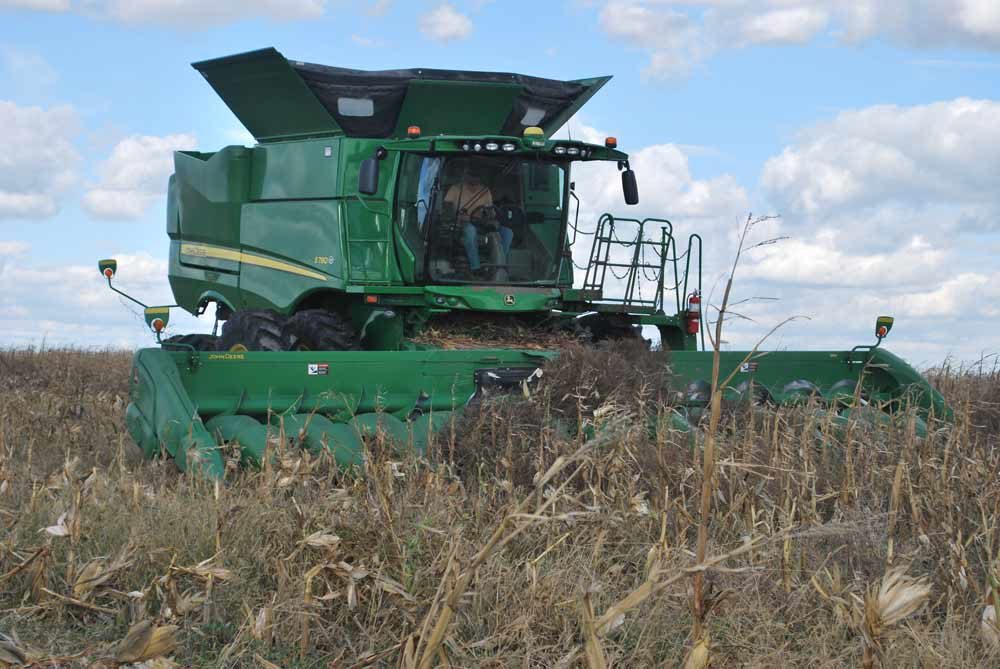Farming is challenging in northern South Dakota. Winters are frigid and windy; summers are hot and dry and managing moisture is critical. Long dry spells from June to August can cause crops in poorly managed soils to burn up while days with too much precipitation at one time lead to soil erosion that leaves a lasting mark on the landscape.
No-tilling is critical to managing these extremes, says Levi Goetz. “Our growing season is so unpredictable,” Goetz says. “The date when the ground is warm enough to start planting to our first frost date change so much. It’s hard to plan around that.”
Goetz has farmed with neighbor Steve Sawinsky since 2007, when Goetz was in high school in Selby, S.D. Sawinsky asked Goetz if he wanted to help on his operation that been no-tilled since the early 1990s. After learning how to run the combine, Goetz was hooked. In 2014, after college, Goetz returned to the 4,000-acre farm as farm manager.
Dryland Challenges
Goetz says no-till helps them hold onto the moisture they get.
“Out here, moisture is almost always our limiting factor. For us, it’s just unreal how well no-till works to manage it.”
The area averages 18 inches of precipitation annually, mostly from April to late June, followed by a very dry period through late August. The rains resume in September.
“With no-till, the soil’s water holding capacity soil changes,” Goetz says. “It’s incredible how fast we can get into the field after a big rain event.”
Check The Specs...
NAME: Levi Goetz & Steve Sawinsky
LOCATION: Selby, S.D.
ACRES: 4,000
YEARS NO-TILLING: 25 +
CROPS: Corn and soybeans
ANNUAL PRECIPITATION: 18 inches
IRRIGATION: None
LIVESTOCK: 250 commercial cattle (owned by Goetz and his father, Todd)
In October 2021, after an extremely dry summer, they received 3.25 inches of rain in 5 days. However, they didn’t have to stop harvesting and left no tracks.
“You can see how long-term no-till is improving our soil,” he says. “We had no rain this year, and we were still combining corn in October. There’s no way we would’ve been able to park a semi-truck in our fields if we did tillage.”
Goetz says that they have a fairly high organic matter and can hold nutrients in the soil.
“The organic matter has gone up from 3.4% to 4.8% over time,” Goetz says. “With our John Deere DB60 planter, we have the ability to map that as well as the cation exchange capacity.”
But Goetz also uses a simple shovel to evaluate his soils. In the spring, Goetz says that if he digs in the fields, it seems like he digs up more earthworms than soil.
“We have pretty healthy soil,” Goetz says. “We have good pore space, so the soil can hold water. We don’t see a lot of compaction lines,” he says, adding that one good thing comes from the cold South Dakota winters: freezing and thawing helps prevent compaction.
Variable Rate Everything
Goetz and Sawinsky consider the date, soil conditions and weather when deciding when to plant. Yield goals are based on annual grid sampling done by their cooperative.
“We started planting early beans here and it’s working pretty well,” Goetz says. “We’re going to be more aggressive on early beans by planting closer to April 1 — which is very early to be planting in our area — and planting more acres in soybeans. We’re so far north that we can’t plant corn in June.”
The local cooperative spreads fertilizer each spring. With variable rate application, the best spots in the field receive 700 pounds per acre of urea-based nitrogen (N), phosphorus (P), potassium (K) and micronutrients, while other spots only receive 250-300 pounds.
“We try to put down extra P with the corn and we don’t spread any fertilizer before the beans,” he says. “The beans like P, so we try to put it out the year before because P is pretty immobile.”
During corn planting, 5 gallons per acre of liquid 10-34-0 fertilizer are placed in furrow.
No-till stands tend to be uneven, Goetz says, but the yields tell a different story. He notes that yields have increased with no-till over the years, and their yields are at the top end of the county average. No-tilling soybeans early has yielded a couple extra bushels per acre, which is another reason why they’re going to put more acres in beans.
Their planter has been customized with Precision Planting technology with Smart Firmers that help with mapping. Goetz and Sawinsky pull the planter with a Case IH 500 Quadtrac. The 60-foot Deere DB60 planter plants 24 rows, 30-inches apart. Corn is planted at 17,000-36,000, depending upon the field’s potential yield.
NO-TILL TAKEAWAYS
- Swapping out OEM row cleaners and stalk rolls with aftermarket alternatives can be very important for managing residue in no-till corn fields.
- No-tilling helps the soil create more pore spaces, to hold addiitonal water.
- The freeze/thaw cycle can help break up and prevent soil compaction.
Goetz and Sawinsky haven’t seen any problems with no-tilling both corn and soybeans in 30-inch rows.
“I’d like to go a little narrower,” Goetz says. “The crop canopies sooner, helping with weed pressure. The planter floats really well on wet ground. That’s a big plus for us,” Goetz says, adding that getting a stand established in a lot of corn residue is tough.
“We spend a lot of money on Dawn GFX row cleaners to move residue out of the way so we can get a stand in high residue situations,” he says. “The row cleaners can be adjusted from the cab and use hydraulics to maintain ground pressure.”
Goetz and Sawinsky rebuilt their Deere 612C corn head with 360 Yield Center chain roll stalk rollers, which crush the stalks so that they break down faster.
“All these stalks contain nutrients and when they’re blowing off, we’re losing money,” Goetz says.
Scouting for Trouble
Goetz scouts every field at least weekly for disease issues or deficiencies. If he sees deficiencies, he does tissue sampling to get ahead of it.
The pair has been fighting a sulfur (S) deficiency. When corn has three leaves to about knee high, it starts turning yellow and doesn’t grow as fast. In years with more rain, yields don’t suffer. When plants are suffering from S deficiency and drought, the plants draw up more water to replace the nutrients, costing valuable moisture and hurting yields.
The occasional disease can create more challenges. One year, the corn crop was hit by Goss’s wilt, cutting yields by 25-30%.
“That stays in the soil for years,” he says. “We try to watch that and choose resistant varieties.”
White mold has plagued their soybeans since 2016, which is why they’ve opted to use 30-inch rows.
“The best way to fight white mold is airflow under the crop canopy, and wider rows help with that,” Goetz says. “That’s why we aren’t really aggressive on trying to go narrower.”
Kochia is the main weed species they deal with. In a drought year like 2021, the weed becomes nearly impossible to kill.
“It seems like in dry years, the kochia doesn’t take in the chemical,” Goetz says. “The kochia goes into defense mode, so it’s defending itself from everything if you don’t catch it when it’s small.”
He says no-till helps suppress weeds, since there is no bare dirt in their fields, but the pair still relies heavily on Roundup and dicamba for additional weed control.
Goetz is also trying non-chemical tactics for weed control. One year, the pair had waterhemp that got too big to spray, so Goetz bought a 24-inch lawnmower and mowed down the waterhemp so it wouldn’t go to seed.







